What’s All This Mean?
Dragon 2, also known as Crew Dragon, is the first private spacecraft that can carry a crew into low-Earth orbit. Following the successes of Demonstration Mission 1 (DM-1) and the In-Flight Abort test missions, Space Exploration Technologies (SpaceX) is preparing for the DM-2 mission scheduled for May 30, 2020. NASA astronauts Douglas G. Hurley and Robert L. Behnken will launch to the International Space Station (ISS) on top of a brand new Falcon 9 rocket (B1058.1) in their Crew Dragon (C206) spacecraft.
Liftoff Time
|
May 30, 2020 – 19:22:45 UTC | 15:22:45 EDT |
|---|---|
Mission Name and what it is? |
SpaceX Demonstration Mission 2 (DM-2), First Crewed Mission |
Launch Provider
|
SpaceX |
Customer
|
NASA |
Rocket |
Falcon 9 (Block 5) Serial Number B1058.1 |
Launch Location |
Launch Complex-39A (LC-39A) at Kennedy Space Center, Florida |
Payload mass |
12,055 kg (26,577 pounds) |
Where’s the spacecraft going? |
Docking with the International Space Station (ISS) in low-Earth orbit |
Will they be attempting to recover the first stage? |
Yes |
Where will the first stage land? |
510 km downrange on the Autonomous Spaceport Drone Ship, Of Course I Still Love You (OCISLY) |
Will they be attempting to recover the fairing? |
No, there is no fairing |
This will be the: |
|
Where to watch |
SpaceX official Stream
Tim Dodd, the Everyday Astronaut, will stream LIVE The Everyday Astronaut and NASA teams strongly urge and request everyone to stay home and obey all local, state, and federal guidelines. Please enjoy the mission with us from home! |

Who are the Astronauts?
Douglas G. Hurley
Doug Hurley is an American test pilot and NASA astronaut. He will be the commander on the Demo-2 mission, meaning he is responsible for the mission’s overall success. As Dragon 2 is fully autonomous, this role doesn’t come with as many responsibilities as in the Shuttle era. Astronauts will only take manual control in case of an emergency, otherwise their spacecraft will dock to the station automatically.
Demo-2 will be Hurley’s third mission, and his first since the retirement of the Space Shuttle. He was the pilot on STS-127, and last flew as the pilot on STS-135, the last ever Shuttle mission. He was on the last American crewed launch, back in 2011, and now will be on the first mission returning Americans to space with indigenous spacecraft. Hurley has been in space for 28 days, 11 hours, and 12 minutes and has never completed an Extravehicular Activity (EVA) also called a spacewalk.
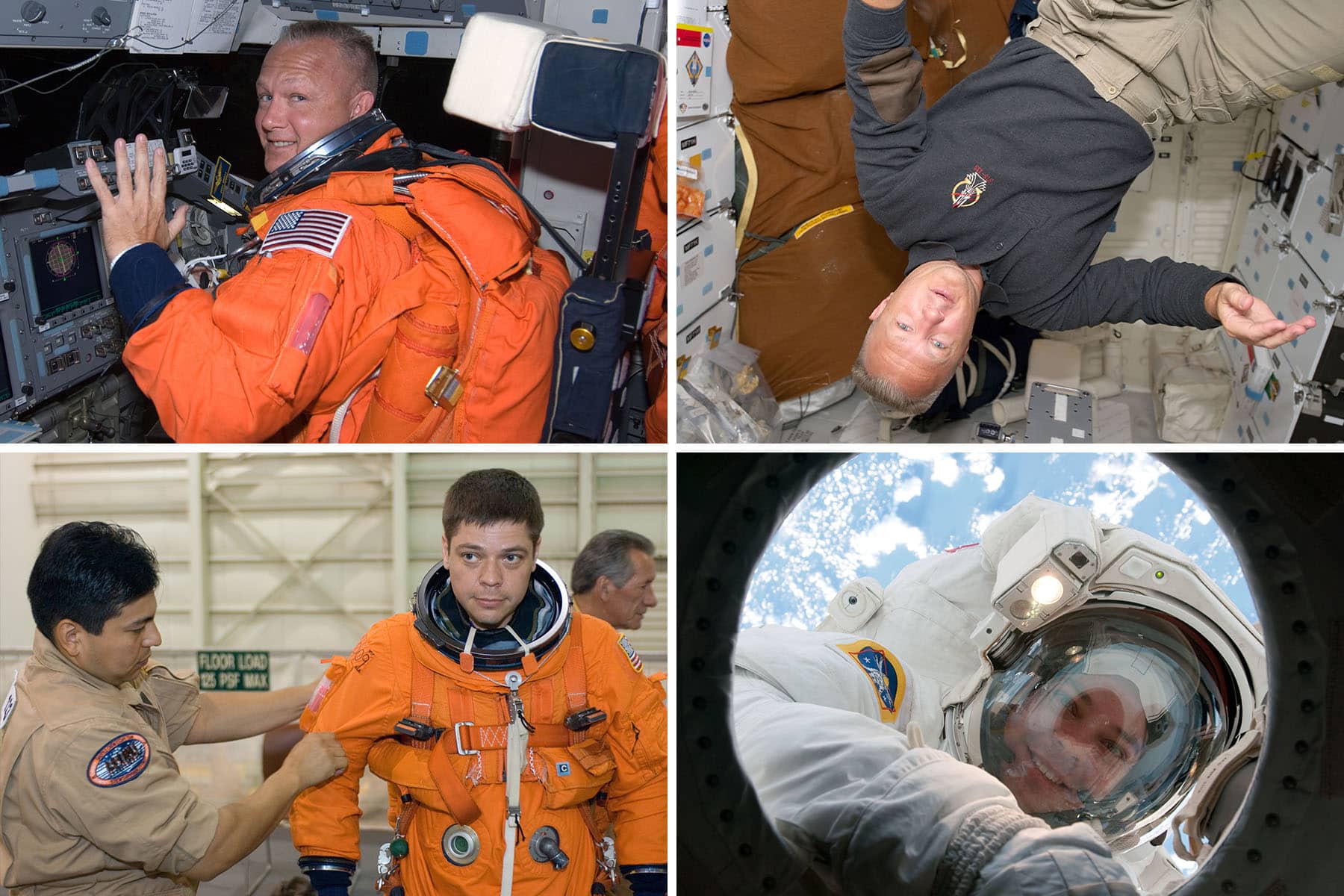
Robert (Bob) L. Behnken
Bob Behnken is a test engineer and NASA astronaut. He will be the pilot on this mission, meaning that he will assist Commander Hurley with navigation in the unlikely event of an emergency. Previously, he was NASA’s Chief Astronaut from 2012 until 2015 and returned to the active rotation. He married fellow astronaut K. Megan McArthur, who now serves as the deputy Chief Astronaut.
Behnken first flew in space onboard the Space Shuttle Endeavor on STS-123 as a mission specialist. His second spaceflight was on STS-130, also as a mission specialist. So far, he’s spent 29 days, 12 hours, and 17 minutes in space. He performed six EVAs while the Shuttle was at the ISS. He completed three spacewalks on STS-123 and another three on STS-130, for about 37.5 hours outside Station.
What is Falcon 9 Block 5?
SpaceX’s Falcon 9 rocket first flew in 2010. Since that time, Falcon 9 has flown for a total of 85 times. 82 of those launches being fully successful, one partially successful (CRS-1), one ground anomaly (AMOS-6), and one in-flight failure (CRS-7). DM-2 will be the launch vehicle’s 85th flight. Over the years, it has gone through several upgrades and iterations, not including the Falcon Heavy. The current version is the Falcon 9 Block 5, introduced in 2018 and is now the main version in operation today.
The Block 5 is the final iteration of the Falcon 9 and rated to carry humans into space. Block 5’s goal was to apply all the lessons that SpaceX learned into a human-rated, reusable rocket, capable of sending Crew Dragon into orbit.
Human-rating
The first change NASA required to human-rate the Falcon 9 was to put it into a design freeze. Before Block 5, no two Falcon 9s were the same, according to a SpaceX representative. Because of these continual improvements, NASA required SpaceX to fly seven missions in a row with no changes to the launch vehicle.
The second major change required the addition of a redesigned carbon over-wrapped pressure vessel (COPV). It was COPVs in the upper stage that caused the two previous Falcon 9 failures (AMOS-6 and CRS-7).
Reusability Tweaks
There were also many modifications in the Block 5 booster stage related to better reusability that were not critical for human-rating. SpaceX reinforced the landing legs, upgraded the grid fins, added a carbon fiber interstage, added a heat resistant external paint, and upgraded the engines. For more information about the changes in Block 5, and the other Blocks of the Falcon 9, check out this video by the Everyday Astronaut:

Dragon 2’s Falcon 9 on DM-2
The booster supporting this mission is B1058.1. It was static fire tested at SpaceX’s McGregor, Texas facility on August 19, 2019 and then shipped to the Kennedy Space Center (KSC). Over the next few months, they will integrate the Falcon 9 and Dragon 2 at KSC Launch Complex-39A (LC-39A).
American Spaceflight
Since the last Space Shuttle, Atlantis, launched on July 8, 2011, the United States hasn’t had a crew-rated spacecraft. In 2010, before that last Shuttle flight, NASA created the Commercial Crew Program (CCP) to replace it. The goal of this program is to create a safe, reliable, and cost-effective way to transport crew from US soil to low-Earth orbit (LEO).
Dragon 2 became one of two winners in this effort to replace the Space Shuttle. NASA selected two commercial partners, SpaceX and Boeing, to provide two redundant rides to the ISS. They wanted to ensure uninterrupted access to space, which is why both companies had to develop spacecraft that fly on different rockets.
Jim Bridenstine on CCP
Because of CCP, NASA administrator Jim Bridenstine stated on February 14, 2019, that NASA wanted “to be one customer of many customers in a robust commercial marketplace.” He then further explained that NASA will use the precedent set in CCP to return to the Moon. The fixed price model used in CCP is also being used for the Artemis human lander system (HLS). He envisions that customers will not only include other nations but also private space tourism.

The Worm is Back
As a memento to returning American astronauts on American rockets from American soil to space, NASA and SpaceX decided to bring back the worm logo on the rocket. They painted the worm logo on the first stage, and will probably appear on the second stage and or the Crew Dragon. NASA stated that “the agency is still assessing how and where it will be used, exactly.”
In the 1970s, after the blue “meatball” logo was too hard to print, NASA created a modern and simple logo to replace the meatball, creating “the worm.” The logo’s name is unofficial, and is called that because of how it looks. This logo flew on most NASA missions starting in 1975 and all through the Shuttle era until the turn of the century.

Mission Profile for Falcon 9 & Dragon 2
You may wonder why SpaceX is landing the booster downrange despite Crew Dragon being such a light payload? The answer is simple: to ensure the crew can safely abort during any part of the mission.
To ensure a safe abort, SpaceX must fly Dragon 2 on a shallower and flatter flight profile than on a cargo mission. This means that the Falcon does not have the fuel margin to return to Cape Canaveral Landing Zone 1 (LZ-1). Below is a comparison of the flight profile of an ISS Commercial Resupply (CRS) return to launch site (RTLS) mission and a CCP Autonomous Spaceport Drone Ship (ASDS) mission.
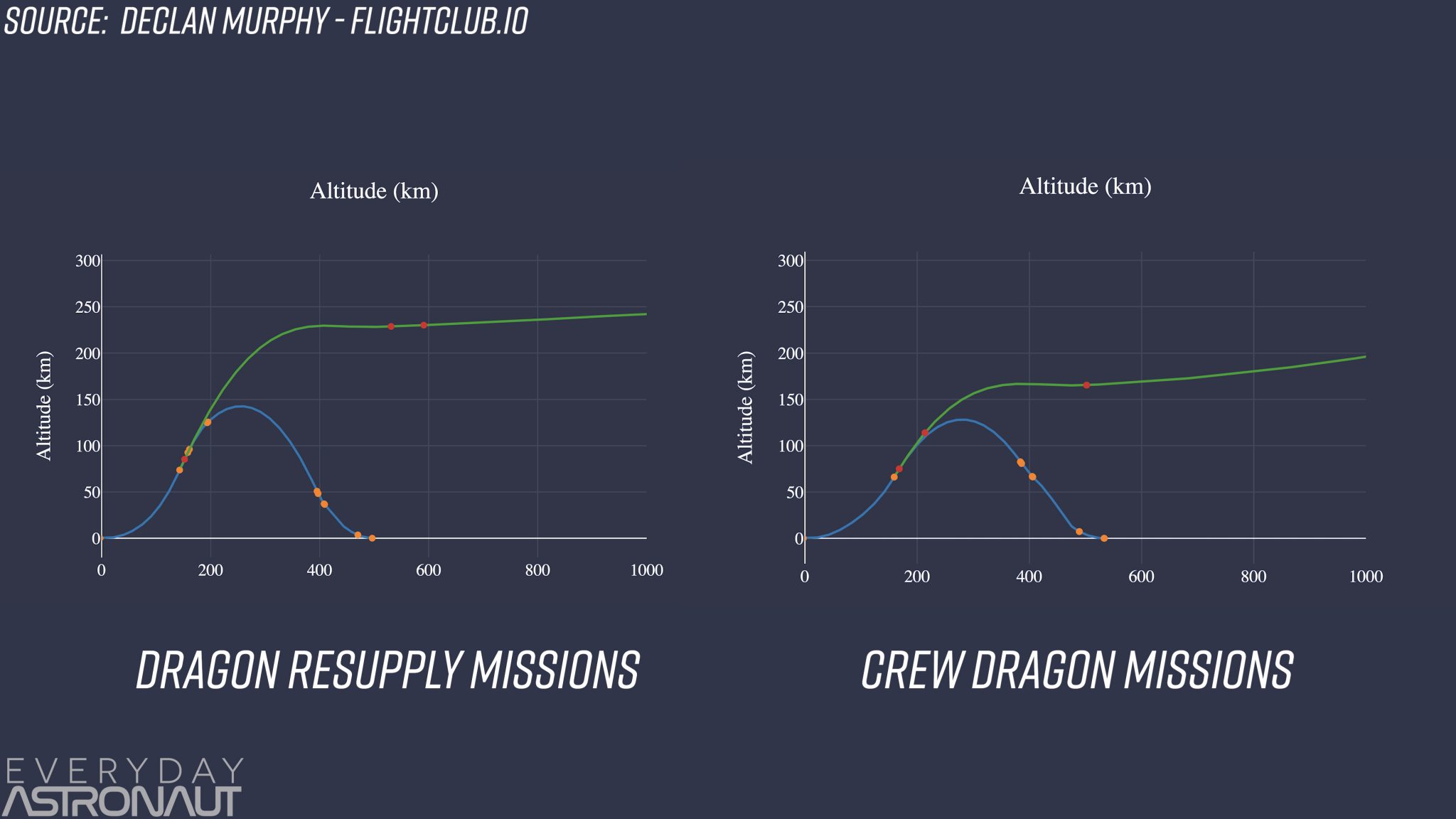
Falcon 9 First Stage
The first stage will burn for about two minutes and 35 seconds before shutting down and separating from the second stage, which is carrying Crew Dragon. The booster will then perform a boost back burn, a reentry burn, and finally a landing burn before landing on SpaceX’s ASDS Of Course I Still Love You (OCISLY). SpaceX expects the first stage to land about nine minutes and 52 seconds after liftoff. During ascent–assuming there isn’t an abort–the Dragon 2 will pull up to 3-Gs (29.4m/s/s).
Falcon 9 Second Stage
The Merlin 1-D vacuum engine on the second stage of the Falcon 9 will burn for approximately six minutes and 17 seconds, propelling the Dragon 2 to LEO. Dragon 2 will separate from the second stage about 11 minutes after liftoff. The nosecone will open about 60 seconds later. After performing a series of maneuvers, Dragon 2 will dock with the ISS approximately 19 hours after launch. NASA TV will provide live coverage of this.
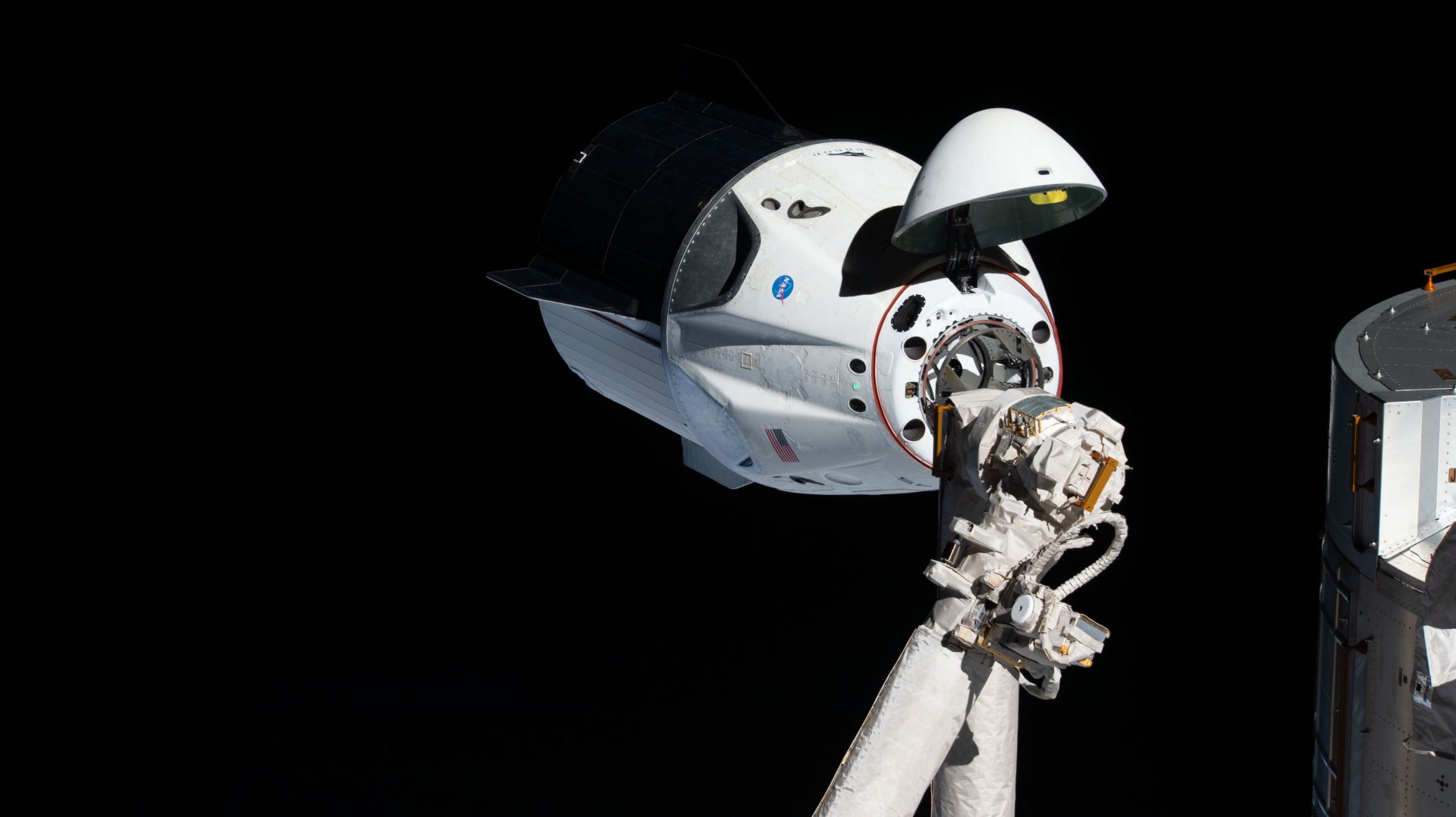
The Dragon 2 spacecraft was originally planned to remain at the station for 8 days, but the duration has now been extended to around three months (with an upper limit of 110 days), before undocking from the station. Dragon will then distance itself from the station, ditch its trunk, then perform its deorbit burn approximately five hours later. After reentry, Dragon will splashdown in the Atlantic ocean. NASA TV will provide coverage of these events. Go Searcher, Go Navigator, and other vessels of SpaceX’s east coast fleet will recover Dragon after splashdown.

What’s new on Dragon 2 Since the Last Launch?
Since Dragon 2’s first launch on SpaceX’s DM-1 mission, there have been several changes to it. We’ll go over those changes below, and explain how they made the spacecraft safer. The delays these changes caused were worth it, as it is a better spacecraft than the one that launched to station in March 2019.
SuperDraco Burst Disks
On April 20, 2019 SpaceX suffered an anomaly to a Dragon 2 on the test stand that destroyed the DM-1 (C201) spacecraft. They were performing extreme vibration and over pressurization testing on the spacecraft. The tests were for the DM-1 spacecraft’s next mission, the inflight abort test.
After going over the data, SpaceX concluded that the failure occurred in Dragon 2’s SuperDraco abort motors. Before ignition, a slug of nitrogen tetroxide leaked past a helium check valve into the pressurization system. During pressurization, a phenomenon known as fluid hammer propelled the same slug through the check valve. This event, coupled with the oxidizer rich environment, set fire to the titanium components and lead to an explosion. The failure caused SpaceX to have to switch the one-way valve to a burst disk and add a protective door on the abort motors.
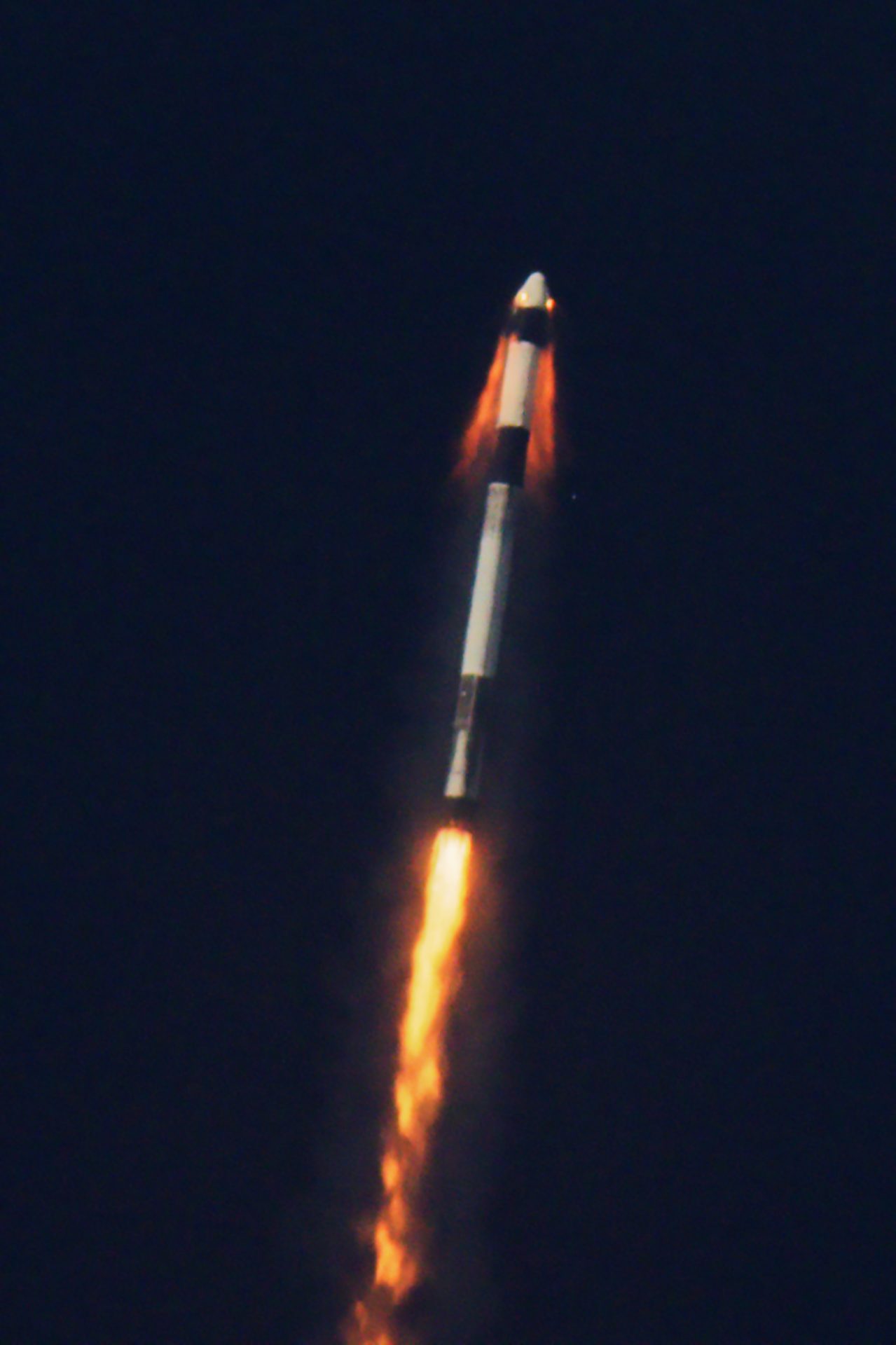
Mark 3 Parachutes
Another big change to Dragon 2 is the parachutes. The Mark 2 parachutes worked flawlessly on SpaceX’s uncrewed DM-1 in March 2019. However, on October 11, 2019, during an update on Dragon 2, Jim Bridenstine and Elon Musk announced that SpaceX was redoing the parachute system.
After going over DM-1’s post-flight data, SpaceX found that the risers were experiencing more force than the models predicted. Interestingly, this wasn’t their fault. Since the Apollo era, NASA had been using the same models for modeling forces on parachute risers. Only after SpaceX equipped the Dragon 2 with additional sensors for the parachute mechanism that the models’ force predictions proved inadequate.
This forced them and Boeing to have to reinforce the risers. This means their volume and weight had increased, causing the parachutes to need more surface area. As a result, the parachutes would no longer fit in the preexisting housing. To compensate for this, SpaceX switched to zylon, allowing them to overcome these changes. The Mark 3 parachutes incorporate these changes.

4-Seat Crew Dragon
The final change to Crew Dragon was the removal of the second row seating after NASA was not happy with the splashdown data during DM-1. NASA thought the forces applied on the astronauts was too high, causing SpaceX to remove the bottom row seats. This new seat configuration reduces the crew from seven astronauts to four.
To learn more about SpaceX’s Dragon 2 and Boeing’s CST-100 Starliner, check out the video above by the Everyday Astronaut.
Mission Timeline Video
Weather Launch Criteria
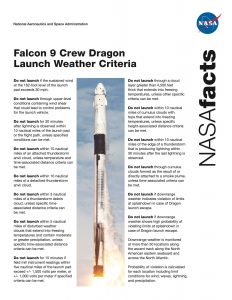
There are several weather criteria that need to be nominal for the Falcon 9 to launch with a Crew Dragon. First, there is the local weather around Cape Canaveral, and outwards to 370 km northeast. On top of that, there are 50 downrange abort locations along the eastern coast of North America and off the coast of Ireland.
Weather in the abort zones could cause a scrub on launch day. Downrange weather is monitored by the 45th Space Wing Weather Squadron in consultation with the Department of Defense Human Space Flight Support (HSFS) Office Rescue Division. Abort zone weather scrubs happened occasionally during the Space Shuttle as well. For details of all the weather criteria, click on the image to the right. For the latest launch weather, see the daily forecast issued by the 45th Weather Squadron.
DM-2 Livestream with Everyday Astronaut
Join Tim Dodd, the Everyday Astronaut, will stream this launch. Come out to ask questions and join the conversation live! If you want the best way to know when a launch is happening, monitor the Prelaunch Previews page. Finally, the SpaceX Fleet website tracks the recovery ships!





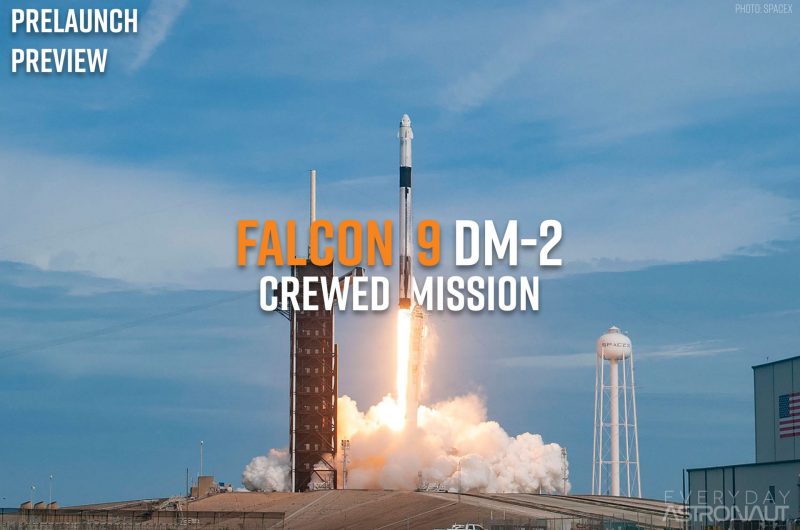

Why does the super heavy booster have 6 landing legs and they stick out but a falcon 9booster has 4 landing legs and they are not sticking out???????
This is something that we don’t know for sure, but we can only speculate on. First of all, Elon has said on twitter that the legs on Superheavy are going to be larger; this was something that a lot of people have been expecting. As to why they are static instead of actuated as on Falcon the best reason I can think of is that Falcon was built a rocket then reusability was added later, while Superheavy and Starship are built from the ground up for rapid reflight. So, it may be that this is the lightest and easiest way; in fact, SpaceX spends a lot of time resetting landing legs.
As to why the number is different once again I bet this is because SpaceX has done a lot of analysis trying to figure out what gives them the best balance for rapid reflight and lack of weight.
Great questions and thanks for checking site out!
“… SpaceX switched to zylon, allowing them to overcome these changes. ”
Can you briefly elaborate on zylon? What is it, where is it used, and what material is it replacing?
Zylon is a synthetic fibre material that has higher tensile strength than Kevlar. Kevlar is used in bullet-proof vests. Mk3 parachutes use Zylon suspension lines because it is far less likely to fail than the weaker nylon Mk2 lines. Suspension lines connect Crew Dragon to its parachutes. It was these nylon lines on the Mk.2 parachutes that had an unacceptable failure mode. Hope this answers your question FootNewtons?
Very nice (as always), thank you very much. And very informative (as always).
Declan Murphy’s graph is very interesting too…
PS: You wrote vesicles instead of vessels (‘…and other vesicles of SpaceX…’)
Thanks for the heads up, no more vesicles 😀
Thanks for the kind words about the article! Sorry about the typo, that is my bad! Thank you for respectfully pointing it out!
Great article & summary of all the technical points. Definitely tells us much more than NASA or SpaceX & in a very understandable & user friendly format. Only a couple months ago I knew basically nothing about all this but have learned a ton from all your videos & blogs. Great work!!
Very informative article.
So the Crew Dragon will remain attached to the ISS for up to 3-months?
How about Hurley & Behnken? Will they return to earth in the same capsule? Will any other ISS astronauts return on that capsule?
Can any other capsules dock with the ISS while Crew Dragon is attached? (Soyuz or Starliner?)
Crew Dragon will be in orbit for a minimum of a month to a max of 119 days. They will return in the same spacecraft with no other people. There are 4 docking ports on the Russian side for Soyuz. There are 5 on the American side for Dragon and Starliner.
A bit of nitpicking here but…
The US segment has 5 available docking ports but only 2 of them are outfitted with the international docking adapter (IDA) that the crew dragon or starliner can dock to.
Thanks for a great article!
Don’t forget Little Earthy! I think she’ll be coming home with Doug and Bob, too! 🙂
Are the same 2 returning in dragon because the other astronauts on the station aren’t trained on dragon or for another reason?
Typo?
“APRIL 27, 2020 IN COMMERCIAL CREW NASA NEWS PRELAUNCH PREVIEW SPACEX”
That’s May 27th right?
Yes, it is May 27, 2020. May I ask where you have seen that? I can’t find it. It might be that one of my colleagues has already fixed the typo.
This is the publish date. So the article was published on April 27th. Launch is May 27th.
Why does Dragon do an ocean splashdown? Isn’t it way easier to reuse something that lands on land like the Starliner?
If you recall, originally they were going to purposively land at LZ-1. But after NASA wasn’t interested in this idea it was easier to just land in the ocean than to retrofit systems to land on land.
Given how much like Matt Damon Bob looks, will they be taking potatoes?
Thanks for the amazing info as usual. I have a question about the following sentence:
“SpaceX’s Falcon 9 rocket first flew in 2010. Since that time, 84 more launches occurred, with 81 of them being fully successful, one partially successful, and one in-flight failure”
The wording makes me think there were 85 flights in total. Are 2 launches missing from the statistics here? 81 + 1 + 1 = 83
Thanks for all the amazing info!
Thanks for the kind words, it means a lot! Fantastic question!
As of right now, there have been 84 Falcon 9 flights. The article says 84 more flights have occurred because there is 1 more SpaceX mission before DM-2: Starlink 7.
So, ahead of this launch there will have been 82 fully successful flights, 1 partial failure(CRS-1), 1 in-flight failure (CRS-7), and 1 ground failure (AMOS-6), making DM-2 the 86th flight.
I’ll update the article to make that a bit more clear!
Thanks!
we are marking the first human spaceflight in almost a decade
You know, there is a world outside of the United States, right?
Maybe “we” means “we, Americans” and in that case he’s right.
I saw the SpaceX dragon 2 inflight abort test with my own eyes!!!!!!!!
Great article! Leaves SpaceX and Nasa pages and information presentation in the wind! A really concise, informative read, many thanks! Looking forward to watching your stream on launch. (Manchester, U. K.)
Since they are landing the booster down range, why do they perform a boost back burn? Is it just to slow down and begin descending rather than actually changing direction?
Is anybody here going to the launch?
Tim will cover launch but will NASA have livestream of some of the events? Like crew arrival, hatch closing, etc? It would be cool to have all 5 hrs coverage but I guess it’s too much too ask 😀
I’ve been trying to find the press kit for this launch which NASA used to have. I like to follow along when I have the time. Anyone knw if they have one for this flight?
Wonderful information. Concise and understandable.
There is a minor typo in the paragraph on the SuperDraco burst disk. The sentence says, ” This event… set fire to the titanium components and lead to an explosion. ” Led was spelled like the metal rather than as the past tense of the verb.
Thanks for such a clear explanation of all this.
Most up-to-date weather report I could find if anyone is interested:
https://www.patrick.af.mil/Portals/14/Weather/Falcon%209%20Dragon%20Crew%20Demo-2%20L-1%20Day%20Forecast%20-%2027%20May%20Launch.pdf?ver=2020-05-26-075051-140
BTW: At one point there is a typo with CPP instead of CCP.
I think that in the stream there is a minor fault, i think it has to be 12 AM that Tim go’s live.
It can be the language but I think if you start watching from 12pm I think you miss it.
Noon is 12:00 p.m., midnight 12:00 a.m. Times from the Kennedy Space Center (KSC) or from Cape Canaveral are quoted in the Eastern time zone. Daylight Savings Time is in force now until early November in the Eastern time zone. That means it is four hours behind UTC until early November.
What will happen if the launch is canceled?
why does it take about 16h to reach the space station? does the astronauts have the chance to sleep? it seems that thay will not sleep more than 24h!!!
Simple answer, it takes less propellant and is less complicated. Because Demo-2 is a test mission, NASA and SpaceX want to keep things simple. On a future mission, Crew Dragon probably will perform a rapid rendezvous.
After finding one typo and reporting it, I checked to see if there might be others. There were about 10, unfortunately.
I don’t know much about rockets. In fact I’ve learned most of what I know from Tim, but as a long-time proofreader, I thought this was one way I could help.
Under the heading WHAT IS FALCON 9 BLOCK 5?
“The current version is the Falcon 9 Block 5, introduced in 2018 and is now the main version in operation today.” Too many “is”es and says it’s the currently used version three times in different words. I suggest “The Falcon 9 Block 5, introduced in 2018 is now the main version in operation.
Under the heading HUMAN-RATING
“Because of these continual improvements, NASA required SpaceX to fly seven missions in a row with no changes to the launch vehicle.” Not really because of the improvements, but because changes can cause new dangers. Could this be improved to, “Because these continual improvements might introduce unknown problems, NASA required SpaceX to fly seven missions in a row with no changes to the launch vehicle.”?
“The second major change required the addition of a redesigned carbon over-wrapped pressure vessel (COPV).” Several types of fiber can be used, e.g. carbon and/or kevlar. The acronym COPV means “composite over-wrapped pressure vessel” in every SpaceX publication I have seen. [ I do agree that for the novice, ‘carbon over-wrapped’ may communicate a more useful image in the mind than ‘composite over-wrapped’ ]
Under the heading JIM BRIDENSTINE ON CCP
“Because of CPP, NASA administrator Jim Bridenstine stated on February 14, 2019, that NASA wanted “to be one customer of many…” CCP ?
Under the heading THE WORM IS BACK
“They painted the worm logo on the first stage, and will probably appear on the second stage and or the Crew Dragon. Fix as “and it will”
“This logo flew on most NASA missions starting in 1975 and all through the Shuttle era until the turn of the century.” Is this true? Shuttle images from the last half of 1992 show the meatball. I find this information when I search for ‘worm logo’:
NASA “worm” logotype[edit]
In 1974, as part of the Federal Graphics Improvement Program of the National Endowment for the Arts, NASA hired Richard Danne and Bruce Blackburn to design a more modern logo.[7] In 1975, the agency switched to the modernist NASA logotype, nicknamed “the worm”, a red, stylized rendering of the letters N-A-S-A.[8] The A’s horizontal bar is removed in the worm logo. The NASA logotype was retired from official use on Friday May 22, 1992.[7] The design was used only for special occasions and commercial merchandising purposes approved by the Visual Identity Coordinator at NASA Headquarters until 2020, when it was brought out of retirement by administrator Jim Bridenstine. The re-instated logo was unveiled on the booster for SpaceX’s Crew-Demo 2 Mission.[9] This marked its first official use since 1992.[10].
Under the heading SUPERDRACO BURST DISKS
I already commented on the “led” “lead” typo., so it’s probably fixed by now. It should say “led to an explosion.”
Under the heading MARK 3 PARACHUTES
“Only after SpaceX equipped the Dragon 2 with additional sensors for the parachute mechanism that the models’ force predictions proved inadequate. “ Not a complete sentence. Can be fixed by starting the sentence with “ It was only after SpaceX equipped the Dragon…” OR end it with “… did the models’ force predictions prove inadequate.”
“To compensate for this, SpaceX switched to zylon, allowing them to overcome these changes.” This is not wrong, just a little unclear. Perhaps it could be, “… SpaceX switched to thinner but stronger zylon cord for the risers, allowing them to overcome these changes.
Under the heading 4-SEAT CREW DRAGON
“NASA thought the forces applied on the astronauts was too high, “ Fix as force was or forces were
Thank you for your input. The “meatball” logo was phased in on the orbiters after 1992, when they received major upgrades to the heat shielding. So, orbiters flew with the “worm” well after 1992. We’ll look at your suggestions.
Is there a good website or desktop app to track the Dragon spaceflight to the ISS?
Congratulations T you made your family proud today Great Job out there. Keep up the Great work!
Tim,
I cannot find anywhere what happened to Stage 2 of the DM-2 Falcon 9. From what I’ve read about satellite deployment missions (LEO or GTO) they remain in orbit and depending on remaining fuel they are either deorbited or just decay naturally and burn up. What was done with Stage 2 for this mission? It appeared on the camera near the engine bell that it was coasting once SECO was acheived but after it separated from Crew Dragon it drifted off and there is no indication of what happens to it
Hey Jim!
For most LEO missions the second stage is deorbited. That is what happened for this mission, and the stage reentered at around T+45 min. For GEO and MEO missions the stage will be put in a “grave yard orbit” which means that it is out of the way for other spacecraft and operational satellites.
happy last space shuttle atlantis mission today on july 8 2011 space shuttle atlantis lifted off for the final time on this day 9 yrs ago marking end of US crew space launch capability for 9 yrs but DM-2 ended that gap